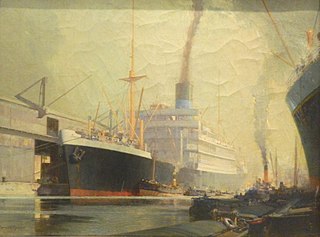
SS Clan Alpine was a UK steam cargo liner. She was launched in 1918 and sunk by a U-boat in 1943.

SS Sarpedon was a UK steam turbine passenger and refrigerated cargo liner launched in 1923. She was the fourth of six ships to bear the name.
SS Tregenna was a cargo steamship that was launched in England in 1919 and sunk by a U-boat in the Battle of the Atlantic in 1940 with the loss of 33 of her 37 crew. She was laid down as War Bulldog, but the Hain Steam Ship Co bought her before she was completed and renamed her Tregenna.

SS Hilary was a British steam passenger liner that was built in 1931 and scrapped in 1959. She spent much of her career on a scheduled service between Liverpool in England and Manaus in Brazil.

SS Uhenfels was a German-built heavy-lift ship that was launched in 1931 for DDG Hansa. She was captured by the Royal Navy in 1939, two months after the start of the Second World War. The UK Ministry of Shipping renamed her Empire Ability and contracted Elder Dempster Lines to operate her. In 1941 a German U-boat sank her by torpedo.

SS Meriones was a Blue Funnel Line refrigerated cargo steamship. She was launched in 1921 on the River Tyne as one of a class of 11 ships to replace many of Blue Funnel's losses in the First World War.
SS Nailsea Meadow was a UK cargo steamship. She was launched in 1936 in Sunderland, England, and sunk by a U-boat in the Indian Ocean in 1943.
Jolee was a 5,500-gross register ton (GRT) Design 1022 cargo ship that was built in 1920 by American International Shipbuilding, Hog Island, Philadelphia, Pennsylvania, United States for the United States Shipping Board (USSB). Launched as Cardington, She was completed as Jolee. She was sold in 1933 to Lykes Brothers - Ripley Steamship Co Inc. She was purchased by the Ministry of War Transport (MoWT) in 1941 and renamed Empire Flamingo. She served until June 1944 when she was sunk as a blockship at Juno Beach.

MV Waimarama was a UK refrigerated cargo liner. She was built in Northern Ireland for Shaw, Savill & Albion Line and launched in 1938. She carried perishable foods, particularly meat, from New Zealand to the United Kingdom.
SS City of Bedford was a British cargo steamship. She was launched in 1924 in Sunderland for Hall Line Ltd of Liverpool, a member of the Ellerman Lines group.
SS Santa Fé was a German refrigerated cargo steamship. She is now a Black Sea shipwreck and part of her cargo is of interest to marine archaeologists.
MV Seaforth was an Elder Dempster Lines cargo motor ship that traded between Liverpool and West Africa. She was launched in 1938 in Scotland and sunk in 1941 in the North Atlantic.
SS Huntingdon was a refrigerated steam cargo liner that was built in Germany in 1920 as Münsterland. The United Kingdom took her as war reparations and sold her to the Federal Steam Navigation Company, who renamed her Huntingdon. She operated between Britain and Australasia until 1941, when an Italian submarine sank her in the Atlantic Ocean.
SS Blitar was a Dutch cargo steamship that was launched in Rotterdam in 1922 and sunk in the Battle of the Atlantic in 1943. She is notable for having fought off three u-boats in succession for nearly ten hours before U-632 finally managed to sink her. 26 of Blitar's complement were killed.
SS Florian was an Ellerman Lines cargo steamship that was launched in 1939 and completed in 1940. A U-boat sank her with all hands in 1941 in the Battle of the Atlantic.
SS Tregarthen was a cargo steamship that was built in Scotland for the Hain Steam Ship Co in 1936. She was sunk with all hands by a U-boat in 1941 in the Battle of the Atlantic.
SS Hartlebury was a cargo steamship that was launched in Scotland in 1934 for J&C Harrison Ltd. A U-boat sank her in the Barents Sea in 1942 when Hartlebury was a member of the Arctic convoy Convoy PQ 17.
SS Algarve was a Danish cargo steamship that was built in 1921 for DFDS. After Germany invaded Denmark in April 1940 Algarve was transferred to the UK Ministry of War Transport. In 1941 an E-boat sank her with all hands in the North Sea.
SS Pennington Court was a British cargo steamship. She was launched in 1924 as Rochdale and renamed Pennington Court in 1927. In the Second World War she carried iron ore, grain and other supplies to Britain. She was sunk with all hands in the Battle of the Atlantic in 1942.
SS St. Elwyn was a cargo steamship that was built in England in 1938 and owned by the South American Saint Line. A German U-boat sank her in the Atlantic Ocean in 1940, with the loss of 24 of her crew.







